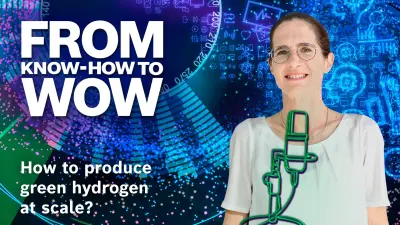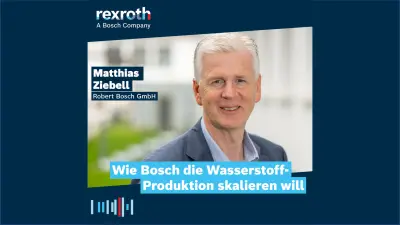Scale the production of green hydrogen: Bosch electrolysis technology and services make it possible
Green hydrogen generated by electrolysis — this is one of the key elements of a sustainable and climate-neutral energy economy. Because hydrogen is a true all-rounder, being an energy carrier, a process gas, and an energy storage medium at the same time. Generating hydrogen with power from renewable energy sources, such as solar, water, and wind power, makes it climate-neutral and therefore green. Our Bosch electrolysis stack provides the centerpiece for your hydrogen production. The stack is manufactured according to our standards of automated and industrialized series production — globally scalable at any time, and, of course, in the usual high Bosch quality. We offer you a future-proof energy system that is independent of fossil fuels and supplied from renewable resources.


Loading the video requires your consent. If you agree by clicking on the Play icon, the video will load and data will be transmitted to Google as well as information will be accessed and stored by Google on your device. Google may be able to link these data or information with existing data.
Loading the video requires your consent. If you agree by clicking on the Play icon, the video will load and data will be transmitted to Google as well as information will be accessed and stored by Google on your device. Google may be able to link these data or information with existing data.
This is how we turn water into hydrogen
In PEM electrolysis, a proton exchange membrane (PEM) serves as an ionically conductive medium between the anode and cathode. When voltage is applied, water is split at the anode. Oxygen is formed, the protons migrate through the membrane to the cathode and react there to form hydrogen.
The benefits: high power density, high H2 output pressure, maximum flexibility, and minimum space requirements, combined with a high level of operational reliability and safety.
The Bosch PEM electrolysis stack is a space-saving powerhouse consisting of several dozens of cells, measuring 85x100x153 cm in size. Our electrolysis stack is capable of producing up to 23 kilograms of hydrogen per hour. This is equivalent to a power input of up to 1.25 megawatts – eminently suited for industrial-scale applications. Hydrogen is produced at an output pressure of more than 30 bar. The high pressure eliminates the need for expensive auxiliary units in many applications.

The Bosch electrolysis stack delivers 23 kg of H₂ per hour at an output pressure of more than 30 bar.
Wide range of possible applications for our electrolysis components
From decentralized plants to cover the on-site demand of production facilities or of hydrogen refueling stations to large-scale industrial solutions
Your reliable technology partner for scalable high-volume production
Anyone who wants to scale successfully in the hydrogen market will find the right and trusted partner in us. We develop novel technologies, such as the PEM electrolysis stack, and transfer the innovation to industrially scalable, high-volume production based on our many years of experience. This is part of our Bosch DNA — high quality and best value for money. Combined with our know-how in the fields of digitalization and networking, we support you by providing accompanying services, from installation, commissioning, and remote monitoring of products to recycling of components at the end of their lifecycle. Alongside our experts, a key element of these services is a digital twin. The virtual copy of the respective electrolysis unit permits an accurate analysis of the system status, helping to keep the electrolysis capacity at the best possible level and thereby optimize operating costs.
The Bosch electrolysis stack is currently in the pilot phase. All technical specifications given are development objectives.








